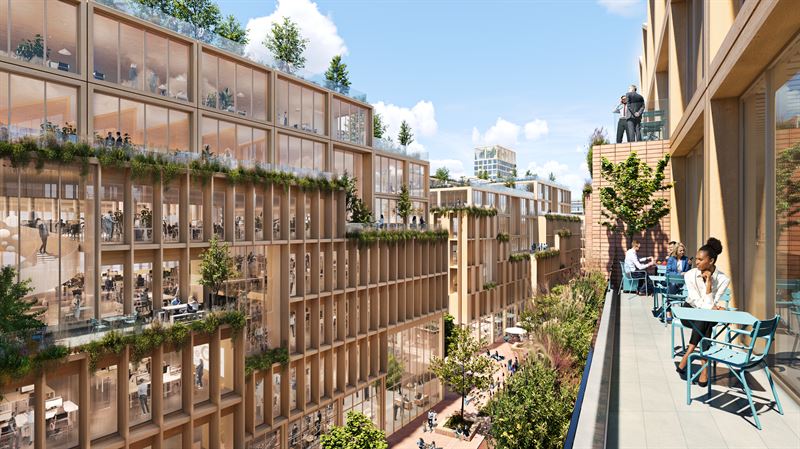As we turn the page into a new decade, one thing remains constant in our pursuit of creating beautiful homes: the essence of exterior design. From capturing curb appeal to reflecting personal style and showcasing attention to detail, the architecture of our homes speaks volumes about us. Whether it’s a cozy cottage or a modern masterpiece, each structure is a canvas waiting to be transformed into an expression of creativity and functionality. But with so many elements at play- from materials and colors to landscaping and structural features- how can one truly master the artistry behind home exteriors? This blog post explores the key components and techniques for creating an exceptional architectural canvas that leaves a lasting impression on passersby.
1. Siding: An Artistic Facade
The siding of a home greatly impacts its aesthetic appeal. It serves as an artistic facade that not only catches the eye but also unifies the exterior design. With options ranging from traditional wood to modern metal panels, the possibilities are endless. Each material offers unique textures and colors that can transform the personality of a home. The key is to choose a material that complements the architectural style and enhances your property’s features.
Siding not only adds visual intrigue but also plays a vital role in protecting your home’s structure. High-quality materials shield against harsh weather, provide insulation, and enhance energy efficiency. With the help of professionals such as the Northwest Exteriors team, choose the right siding material for a stunning and durable exterior. A well-selected siding seamlessly blends aesthetics and functionality, enhancing your home’s architectural canvas.
2. Foundation: Strong and Dependable
Your home’s foundation is more than just the base of its structure; it provides strength and stability to the entire building. When it comes to exterior design, the foundation plays a crucial role in establishing the architecture’s visual impact. It also influences the location and size of windows, doors, and other structural elements. Building a strong foundation is essential for new construction and renovation projects.
The foundation can be used as a design element, with different materials and finishes available to add texture and character. From exposed brick to stucco, the possibilities are endless in creating a unique foundation that adds personality to your home’s exterior. However, it’s important to ensure that the foundation not only looks appealing but also meets structural requirements and withstands the test of time.
3. Roof: A Practical Protector
The roof is often referred to as the “hat” of a home, protecting it from external elements while completing its look. When it comes to exterior design, the roof can have a significant impact on the overall impression of a home. From classic shingles to modern flat roofs, there are countless options to choose from, each offering different styles and functionalities.
The roof is crucial for visual harmony between the home and its surroundings. Cedar shakes can seamlessly blend a house into a wooded area, while metal roofs can add an industrial touch to modern homes. Choose a material that complements the design, meets structural needs, and provides adequate protection.
4. Windows: Framing Your View
Windows are not only essential for bringing in natural light and ventilation but also for framing the view of your home’s exterior. They can significantly impact the architecture by providing balance, symmetry, and visual interest. When designing windows, it’s important to consider both the interior and exterior perspectives, as well as their placement and size.
Choosing the right window frame material is crucial for aesthetics and functionality. Wood frames and metal frames offer unique styles and benefits. The type of glass also plays a significant role in enhancing the look and energy efficiency of a home. With careful consideration, windows can add character and charm to a home’s exterior.
5. Landscaping: Adding Life to Your Exterior
Every architectural canvas is complete with the addition of landscaping. It adds life, color, and texture to a home’s exterior, making it visually appealing and inviting. From lush gardens to manicured lawns, there are endless ways to incorporate landscaping into your exterior design. The key is to create a cohesive and balanced look that enhances the architectural style of your home.
Consider using a variety of plant types, colors, and textures to add depth and dimension to your landscape. You can also use hardscaping elements such as walkways, patios, and water features to enhance the visual appeal of your exterior further. With the right landscaping, you can transform even the simplest of homes into a work of art that leaves a lasting impression.
6. Color: Making a Bold Statement
Color is an essential aspect of any exterior design. From the siding and roof to doors and trim, each element offers an opportunity to make a bold statement that reflects personal style and enhances curb appeal. When choosing colors for your home’s exterior, it’s important to consider factors such as geographical location, architectural style, and surrounding landscape.
Neutral tones can create a timeless and elegant look, while vibrant colors can add a whimsical touch to modern homes. You can also use color to highlight certain architectural elements or create contrast by using different shades and tones. With proper planning and careful consideration, the right color palette can truly elevate your home’s exterior design.
7. Finishing Touches: Details Make All the Difference
As with any masterpiece, it’s often the smallest details that make the biggest impact. In-home exteriors can include elements like lighting fixtures, door hardware, and decorative accents that add personality and charm. Each of these finishing touches can contribute to the overall aesthetic appeal of a home, making it stand out from others in the neighborhood.
When selecting finishing touches, consider the architectural style and material of your home. For example, traditional homes benefit from classic lighting fixtures and door hardware, while modern homes could incorporate sleek and minimalist designs. Additionally, these details can also serve a functional purpose, such as providing additional security or enhancing the exterior lighting.
The essence of home exterior design is a never-ending pursuit, evolving with each passing year and decade. As new techniques and materials emerge, homeowners have endless possibilities to create unique and stunning architectural canvases that reflect their style. Whether it’s through combining different materials or experimenting with bold colors, the key is to continuously push boundaries and strive for excellence in creating the perfect exterior for your home. Remember, a well-designed exterior not only enhances your home’s curb appeal but also adds value and character to your property.







